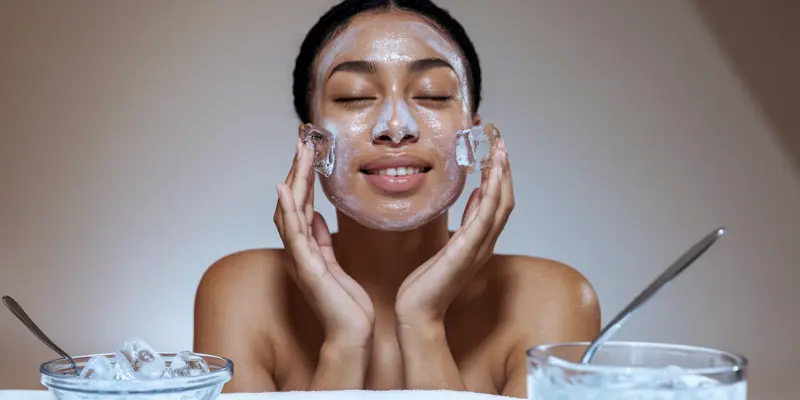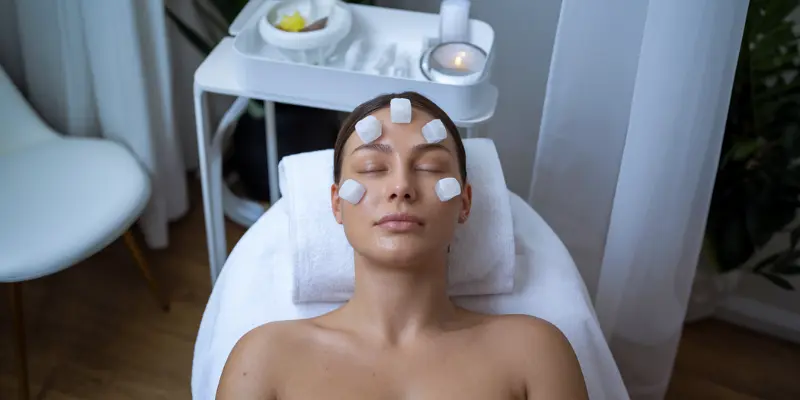How to Do Skin Icing: Benefits, Myths & Precautions
Published: 19 Mar 2025
Skin icing is a popular skincare method that uses cold temperatures to improve the look and feel of your skin. It is easy to do at home and can help reduce puffiness, calm redness, and tighten pores. Many people are adding skin icing to their daily routines because it is affordable, effective, and gentle.
In this article, you will learn what skin icing is, how it works, the benefits it offers, and how to do it safely for healthier, fresher skin. Let’s dive in!
What is Skin Icing?

Skin icing is a skincare method where cold temperatures are applied to the skin, usually with ice cubes, ice rollers, or other cooling tools. This technique is popular for its ability to refresh the skin and provide several benefits by using the effects of cold on the skin’s surface.
How Does Icing Work on Skin?
When cold is applied to the skin, it causes blood vessels to constrict, reducing blood flow to the area temporarily. This process, known as vasoconstriction, helps reduce inflammation, puffiness, and redness. The cold also triggers a response in the skin that helps tighten pores and smooth out any swelling, giving your face a refreshed look.
Benefits of Skin Icing

Skin icing offers several benefits that can improve the overall appearance of your skin. By using cold temperatures, you can help reduce puffiness, calm irritated skin, boost circulation, and even lessen inflammation.
Let’s dive into the details of how each benefit works.
Reduce Puffiness:
Skin icing is great for reducing puffiness, especially around the eyes or on the face. The cold temperature works by constricting blood vessels, which reduces fluid buildup and helps your skin look less swollen.
Here’s how it helps:
- Under-eye bags: Icing can reduce the puffiness around the eyes, making you look more awake.
- Facial puffiness: Cold temperatures help tighten the skin, reducing bloating or puffiness across your face.
- Quick results: You’ll notice a fresher, less swollen appearance almost immediately after using ice.
Soothing Effect:
Skin icing has a cooling effect that helps calm irritated or sensitive skin. It provides instant relief by cooling down the skin and reducing discomfort.
Here’s how it works:
- Reduces redness: Ice can calm areas of your skin that are inflamed or red, making it look more even.
- Soothes irritation: If you have sensitive skin or small irritations from things like acne or sunburn, icing can help soothe and calm the skin.
- Instant refreshment: Applying cold can feel refreshing, especially after a long day or after exposure to heat.
Improved Circulation:
When you apply cold to your skin, it causes your blood vessels to contract and then dilate. This process helps to improve circulation, which can benefit your skin.
Here’s how improved circulation helps:
- Glowing skin: The increase in blood flow brings oxygen and nutrients to your skin, giving you a natural glow.
- Firmer skin: Better circulation can help make your skin look healthier and more toned.
- Reduces tiredness: If you’re feeling fatigued, ice can also help you feel more refreshed by stimulating circulation.
Lessen Inflammation:
Cold therapy can also help calm inflammation, especially after breakouts or any irritation. Using ice reduces the flow of blood to an inflamed area, calming the skin.
Here’s how it works:
- Calms acne: If you have a breakout or irritation, the cold reduces swelling and redness, making the area appear less inflamed.
- Speeds up healing: By reducing inflammation, ice can help the skin heal faster after pimples or other irritations.
- Soothes sunburn: Using ice can also help calm sunburned skin by reducing heat and inflammation.
Skin icing is a simple and effective way to treat various skin concerns, leaving you with smoother, calmer, and healthier-looking skin.
How to Do Icing Safely

Doing icing at home is simple, but it’s important to follow a few basic steps to avoid damaging your skin. With the right technique, you can enjoy all the benefits of using ice on your skin without any risks.
Using Ice Cubes:
If you’re using ice cubes, here’s the best way to do it:
- Wrap the ice: Never apply ice directly to your skin. Wrap an ice cube in a clean cloth or towel. This helps protect your skin from the intense cold.
- Gentle pressure: Hold the wrapped ice on your skin for a few seconds at a time. Move it around gently to avoid applying too much pressure to one area.
- Use an ice roller: If you want a more even application, you can use an ice roller. It’s designed to be used on the skin, so it’s less likely to cause discomfort.
Skin Care Tools:
There are other tools designed specifically for using ice on your skin that can make it even easier:
- Ice globes: These are glass spheres filled with a cooling liquid. They glide smoothly over the skin, providing an even cold treatment.
- Ice rollers: These are small rollers that you can freeze. They are easy to use and spread the cold evenly across your face. These tools are great for those who want more precision with their icing or prefer not to bother with wrapping ice.
Avoiding Damage:
To keep your skin safe, here are some tips:
- Don’t apply ice for too long: Limit the icing session to 1–2 minutes in each area. Long exposure to cold can irritate your skin.
- Avoid direct contact: Always wrap the ice or use tools to avoid frostbite or skin irritation.
- Take breaks: If you’re icing for longer periods, give your skin time to warm up between sessions.
Common Myths About Skin Icing
There are some common myths about skin icing that can confuse people. Let’s take a look at them and clear up any misunderstandings so you can make the most of this simple skincare method.
Icing Freezes Your Skin:
Some people believe that icing can freeze your skin, but that’s not true. When done correctly, icing cools your skin, but it doesn’t freeze it. The key is to wrap the ice in a cloth or use a skincare tool, which prevents direct contact with your skin and protects it from extreme cold.
It’s Only for People with Puffy Skin:
While icing is great for reducing puffiness, it’s not just for those who experience puffiness. Icing can benefit all skin types. It helps soothe irritation, reduce redness, improve circulation, and even tighten pores. Whether you have dry, oily, or normal skin, using ice can improve your skin’s health and appearance.
When to Use Icing
Knowing the right time to use icing can help you get the most out of it. Whether it’s to reduce puffiness in the morning or calm your skin after a workout, timing can make a big difference.
Best Times to Do Skin Icing:
- In the Morning for Puffy Eyes: If you wake up with puffy eyes, applying ice for a few minutes can help reduce the swelling and make you look more refreshed.
- After a Workout: After exercising, your skin can feel hot and irritated. Icing helps calm down redness and cools your skin back to normal.
- Before Applying Makeup: Icing can tighten your pores and reduce puffiness, giving you a smoother base for makeup.
How Often to Practice Icing
For best results, you can practice icing 3-4 times a week. Doing it too often may irritate your skin, especially if you have sensitive skin. Keep it simple and pay attention to your skin’s needs.
Using icing at the right time and with the right frequency will help you get the most out of this easy skincare technique.
Who Should Avoid Icing?
While icing can be beneficial for most people, it’s not always suitable for everyone. If you have certain skin conditions or sensitivities, it’s important to know when icing may not be the best choice for you.
Conditions to Avoid Icing:
- Sensitive Skin: If you have very sensitive skin, the cold can cause irritation or redness. Always test a small area before using ice on your entire face.
- Rosacea: If you have rosacea, icing might trigger flare-ups. Cold temperatures can cause blood vessels to constrict and expand rapidly, worsening symptoms.
- Broken or Injured Skin: If you have cuts, abrasions, or sunburn, avoid icing. The cold can make these conditions worse by further irritating the skin.
If you have any of these concerns or other skin issues, it’s a good idea to consult a dermatologist before trying icing. They can guide you on whether this technique is safe for you.
Conclusion
Skin icing is a simple and effective skincare tool that can help with reducing puffiness, calming irritation, and tightening pores. It’s an affordable and easy addition to your routine that doesn’t require much effort but offers noticeable benefits. Whether you’re looking to reduce under-eye bags or soothe your skin after a breakout, this simple method can be a great choice.
If you’re searching for a new skincare ritual, why not give it a try and see how it works for you?
Have you ever tried this technique? Let us know how it worked for you!

- Be Respectful
- Stay Relevant
- Stay Positive
- True Feedback
- Encourage Discussion
- Avoid Spamming
- No Fake News
- Don't Copy-Paste
- No Personal Attacks

- Be Respectful
- Stay Relevant
- Stay Positive
- True Feedback
- Encourage Discussion
- Avoid Spamming
- No Fake News
- Don't Copy-Paste
- No Personal Attacks






